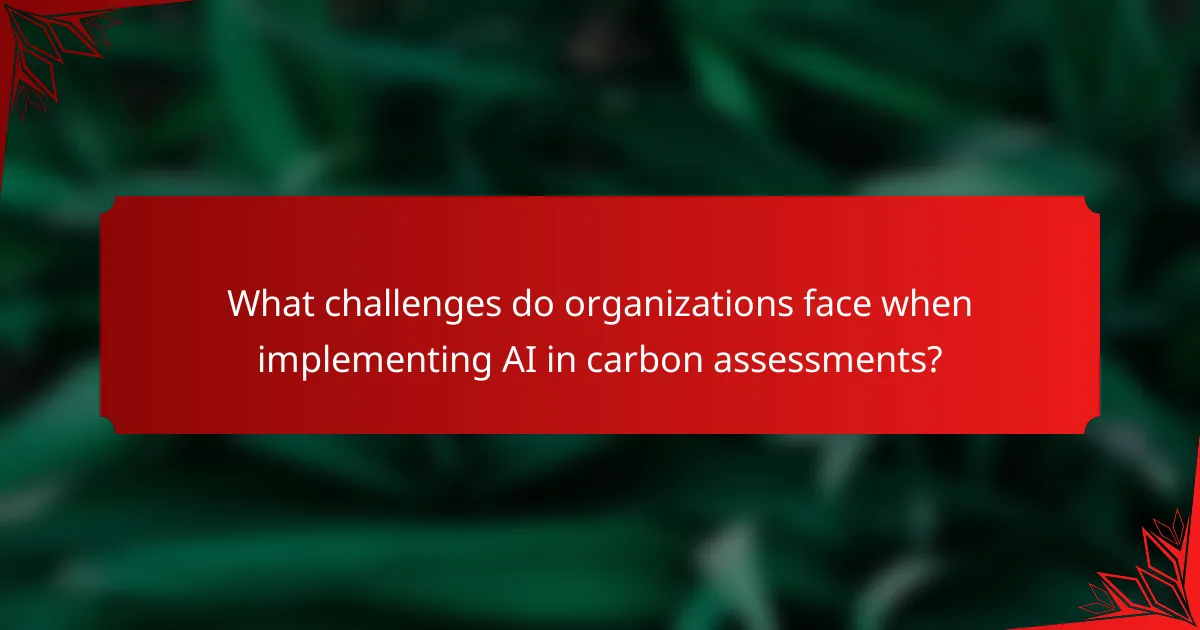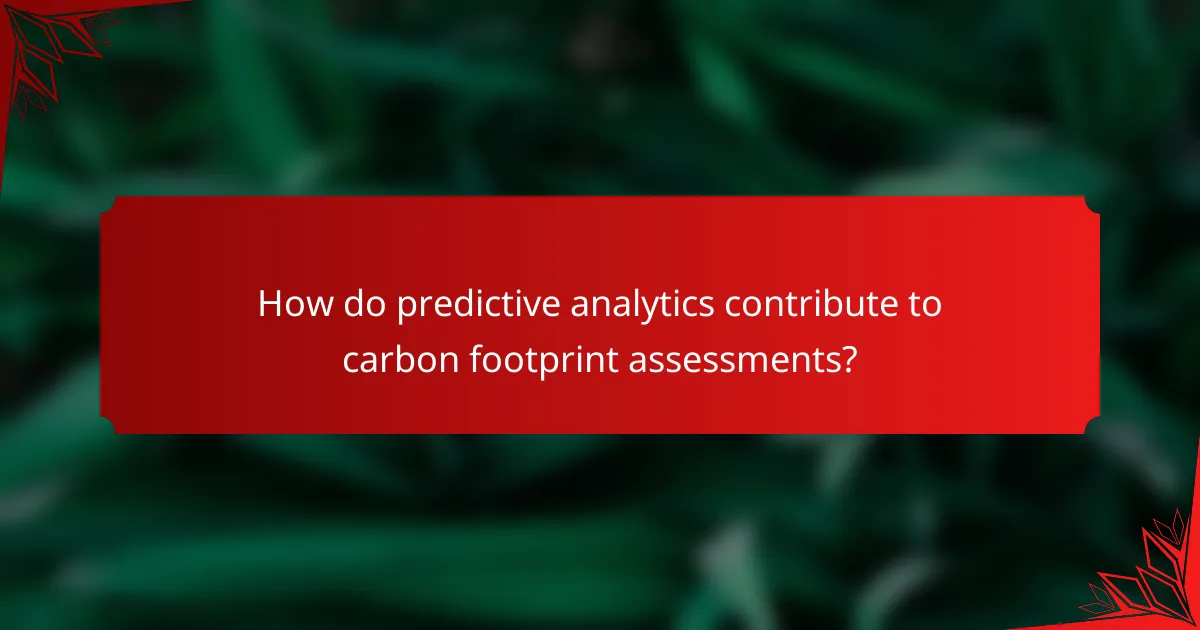AI is revolutionizing carbon footprint assessments by enhancing data collection efficiency and improving the accuracy of emissions tracking. Through the use of machine learning, natural language processing, and predictive analytics, urban planners and businesses can make informed decisions that significantly reduce their environmental impact and optimize resource allocation.

How does AI improve carbon footprint assessments in major cities?
AI enhances carbon footprint assessments in major cities by streamlining data collection, improving accuracy in emissions tracking, and enabling real-time analytics. These advancements help urban planners and policymakers make informed decisions to reduce environmental impact.
Enhanced data processing speed
AI algorithms can process vast amounts of data quickly, significantly reducing the time required for carbon footprint assessments. For instance, traditional methods may take days or weeks to compile data, while AI can deliver insights in a matter of hours or even minutes.
This speed allows cities to respond promptly to emerging environmental issues, such as spikes in emissions due to traffic or industrial activity. By leveraging AI, urban areas can continuously monitor their carbon output and adjust strategies in real-time.
Increased accuracy in emissions tracking
AI improves the accuracy of emissions tracking by utilizing advanced machine learning techniques to analyze data from various sources, such as traffic sensors, satellite imagery, and energy consumption records. This multifaceted approach helps identify emission sources more precisely.
For example, AI can differentiate between emissions from residential areas and industrial zones, allowing for targeted interventions. This level of detail supports compliance with local regulations and helps cities meet sustainability goals more effectively.
Real-time analytics capabilities
Real-time analytics powered by AI enables cities to monitor their carbon footprint continuously, providing immediate feedback on the effectiveness of implemented measures. This capability allows for dynamic adjustments to policies based on current data trends.
For instance, if a city implements a new public transport initiative, AI can analyze ridership data and emissions reductions in real-time, helping to assess the initiative’s impact. This ongoing evaluation fosters a proactive approach to environmental management, ensuring that cities remain agile in their sustainability efforts.

What are the key AI technologies used in carbon footprint assessments?
Key AI technologies in carbon footprint assessments include machine learning algorithms, natural language processing tools, and predictive analytics software. These technologies enhance the efficiency and accuracy of measuring and predicting carbon emissions across various sectors.
Machine learning algorithms
Machine learning algorithms analyze vast datasets to identify patterns and correlations related to carbon emissions. They can process historical data to improve predictions about future emissions based on current activities and trends.
Common algorithms used include regression analysis, decision trees, and neural networks. For instance, regression models can estimate emissions based on variables like energy consumption, while decision trees help in understanding the impact of different operational choices on carbon output.
Natural language processing tools
Natural language processing (NLP) tools facilitate the extraction of relevant information from unstructured data sources, such as reports and articles. These tools can analyze text to identify sustainability practices and regulatory compliance, providing insights into carbon footprint management.
For example, NLP can help organizations assess how well they align with environmental regulations by scanning policy documents and extracting key compliance indicators. This capability allows for a more comprehensive understanding of an organization’s carbon impact.
Predictive analytics software
Predictive analytics software leverages historical data and AI techniques to forecast future carbon emissions. By integrating various data sources, these tools can model different scenarios and assess the potential impact of changes in operations or regulations.
Organizations can use predictive analytics to simulate the effects of adopting renewable energy sources or implementing energy-efficient technologies. This proactive approach helps in making informed decisions that can significantly reduce carbon footprints over time.

How can businesses leverage AI for carbon footprint reduction?
Businesses can leverage AI to significantly reduce their carbon footprint by improving efficiency, enhancing accuracy in assessments, and utilizing predictive analytics. By integrating AI technologies, companies can identify inefficiencies, optimize resource allocation, and enhance their sustainability reporting processes.
Identifying inefficiencies in operations
AI can analyze vast amounts of operational data to pinpoint inefficiencies that contribute to a higher carbon footprint. For instance, machine learning algorithms can assess energy consumption patterns and identify areas where energy is wasted, such as in manufacturing or logistics.
By implementing AI-driven insights, businesses can make informed decisions to streamline operations. This could involve adjusting production schedules or optimizing delivery routes, which can lead to reductions in energy usage and emissions.
Optimizing resource allocation
AI tools can help businesses allocate resources more effectively, ensuring that materials and energy are used in the most sustainable way. For example, predictive analytics can forecast demand more accurately, allowing companies to adjust their supply chains accordingly and minimize excess production.
Utilizing AI for resource optimization can lead to significant cost savings and lower emissions. Companies should consider adopting AI solutions that provide real-time data analytics to enhance decision-making processes related to resource management.
Enhancing sustainability reporting
AI can streamline the process of sustainability reporting by automating data collection and analysis. This technology can help businesses track their carbon emissions more accurately and generate reports that comply with international standards, such as the Global Reporting Initiative (GRI).
By leveraging AI for reporting, companies can improve transparency and accountability in their sustainability efforts. This not only helps in meeting regulatory requirements but also enhances brand reputation among environmentally conscious consumers.

What are the benefits of using AI in carbon footprint assessments?
AI enhances carbon footprint assessments by increasing efficiency, improving accuracy, and enabling predictive analytics. These benefits help organizations make informed decisions to reduce their environmental impact while optimizing resources.
Cost savings through efficiency
AI streamlines the carbon footprint assessment process, reducing the time and resources required for data collection and analysis. Automated data processing can cut assessment times from weeks to days, leading to significant labor cost savings.
By utilizing AI algorithms, companies can identify inefficiencies in their operations, allowing them to implement changes that further reduce costs. For example, predictive maintenance powered by AI can minimize energy waste and lower operational expenses.
Improved regulatory compliance
AI helps organizations stay compliant with environmental regulations by providing accurate and timely carbon footprint data. This capability ensures that companies can meet reporting requirements set by local and international standards, such as the EU Emissions Trading System.
Furthermore, AI can analyze regulatory changes and predict their impact on business operations, allowing organizations to adapt proactively. This foresight can prevent costly penalties and enhance corporate reputation.
Better stakeholder engagement
AI-driven insights into carbon footprints can enhance communication with stakeholders, including investors, customers, and regulatory bodies. By providing transparent and accurate data, companies can build trust and demonstrate their commitment to sustainability.
Engaging stakeholders with AI-generated reports and visualizations can facilitate informed discussions about environmental impact and corporate responsibility. This approach not only strengthens relationships but can also attract environmentally conscious consumers and investors.

What challenges do organizations face when implementing AI in carbon assessments?
Organizations encounter several challenges when integrating AI into carbon assessments, including data privacy, system compatibility, and the need for specialized skills. Addressing these issues is crucial for maximizing the benefits of AI in accurately measuring and predicting carbon footprints.
Data privacy concerns
Data privacy is a significant challenge when implementing AI in carbon assessments. Organizations must ensure compliance with regulations such as GDPR in Europe or CCPA in California, which govern how personal data is collected and processed. Failure to adhere to these regulations can result in hefty fines and damage to reputation.
To mitigate privacy risks, companies should anonymize data where possible and implement robust security measures. Regular audits and transparency with stakeholders about data usage can also help build trust and ensure compliance.
Integration with existing systems
Integrating AI tools with existing carbon assessment systems can be complex and resource-intensive. Organizations often face compatibility issues between new AI technologies and legacy systems, which can hinder data flow and analysis. A thorough assessment of current infrastructure is essential before implementation.
To streamline integration, organizations should consider using APIs or middleware that facilitate communication between systems. Additionally, phased rollouts can help identify and resolve issues without disrupting ongoing operations.
Need for skilled personnel
The successful implementation of AI in carbon assessments requires skilled personnel who understand both AI technologies and carbon accounting principles. There is currently a shortage of professionals with expertise in these areas, making recruitment challenging.
Organizations can address this gap by investing in training programs for existing staff and collaborating with educational institutions to develop curricula focused on AI and sustainability. Partnering with consultants or firms specializing in AI can also provide immediate expertise while building internal capabilities over time.

How do predictive analytics contribute to carbon footprint assessments?
Predictive analytics enhance carbon footprint assessments by enabling organizations to estimate future emissions based on historical data and trends. This approach improves accuracy and efficiency, allowing for better decision-making and strategic planning in sustainability efforts.
Forecasting future emissions
Forecasting future emissions involves analyzing past carbon data to predict upcoming trends. By utilizing machine learning algorithms, organizations can identify patterns in energy consumption and emissions, leading to more accurate projections. For example, a company might predict a 15-20% increase in emissions during peak production seasons based on historical data.
To effectively forecast emissions, it is crucial to regularly update data inputs and consider external factors such as regulatory changes or shifts in consumer behavior. This proactive approach helps organizations stay ahead of potential increases in their carbon footprint.
Scenario modeling for decision-making
Scenario modeling allows organizations to simulate different operational strategies and their potential impact on carbon emissions. By creating various scenarios, such as adopting renewable energy sources or optimizing supply chains, businesses can evaluate the effectiveness of each option in reducing their carbon footprint.
Using predictive analytics tools, organizations can assess the trade-offs between cost and emissions reduction. For instance, a company might analyze the financial implications of switching to electric vehicles versus continuing with traditional fuel options, ultimately guiding them toward more sustainable choices.
Identifying potential risks
Identifying potential risks related to carbon emissions is essential for effective carbon footprint management. Predictive analytics can highlight vulnerabilities in supply chains or operational processes that may lead to increased emissions. For example, a sudden spike in energy prices could significantly impact a company’s carbon output if it relies heavily on fossil fuels.
Organizations should regularly assess these risks and develop contingency plans to mitigate them. This proactive stance not only helps in maintaining compliance with environmental regulations but also enhances overall sustainability efforts. Regular risk assessments can lead to more informed decisions and improved resilience against future challenges.



